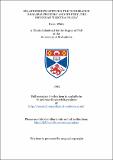Files in this item
Relationships between the nudibranch 'Adalaria proxima' and its prey, the bryozoan 'Electra pilosa'
Item metadata
| dc.contributor.advisor | Todd, Christopher David | |
| dc.contributor.author | White, Helen Judith | |
| dc.coverage.spatial | 221 p. | en_US |
| dc.date.accessioned | 2018-06-26T16:21:43Z | |
| dc.date.available | 2018-06-26T16:21:43Z | |
| dc.date.issued | 1993 | |
| dc.identifier.uri | https://hdl.handle.net/10023/14642 | |
| dc.description.abstract | The cosmopolitan distribution of the anascan bryozoan Electra pilosa manifests itself in the phenotypic plasticity of growth morphology expressed. Longterm field observations of the bryozoan on the essentially ephemeral substrata of the marine macroalgae, Fucus serratiis and Laminaria digitata, at two contrasting sites in Scotland, confirm this. Despite its potential for exponential indeterminate growth, Electra pilosa rarely realises this in the field. Observations show that any pattern of growth is complicated and distorted by the influences of physical (colony abrasion and the dynamics of the substratum) and biotic disturbance (predation by the nudibranch Adalaria proxima). Rather than effect a visible induced defensive response after sustaining injury from mechanical damage or Adalaria proxima, Electra pilosa was demonstrated to maintain a high specific growth rate. It is suggested that this would preclude the settlement of potential competitors and ensure the fitness of this competitively weak, opportunistic species. Adoption of a stellate colony morphology was not concomittant with higher predation susceptibility but rather represented a plastic adaptive response to an ephemeral, dynamic environment. The lack of a metamorphic response to anything other than the presence of live Electra pilosa clearly demonstrated that metamorphosis of Adalaria proxima is by some component of the live, intact bryozoan. This component is neither water- soluble or extractable, and the inductive property is eliminated by homogenisation and freezing. Although hypotheses for this are evaluated, the mechanism of induction and the reasons for this relationship remain unclear. Adaptations to this close nudibranch-bryozoan association are therefore evident in the life history strategies of both species. | en_US |
| dc.language.iso | en | en_US |
| dc.publisher | University of St Andrews | |
| dc.subject.lcc | QL430.5W5 | en |
| dc.subject.lcsh | Mollusks | en |
| dc.title | Relationships between the nudibranch 'Adalaria proxima' and its prey, the bryozoan 'Electra pilosa' | en_US |
| dc.type | Thesis | en_US |
| dc.contributor.sponsor | Natural Environment Research Council (NERC) | en_US |
| dc.type.qualificationlevel | Doctoral | en_US |
| dc.type.qualificationname | PhD Doctor of Philosophy | en_US |
| dc.publisher.institution | The University of St Andrews | en_US |
This item appears in the following Collection(s)
Items in the St Andrews Research Repository are protected by copyright, with all rights reserved, unless otherwise indicated.

